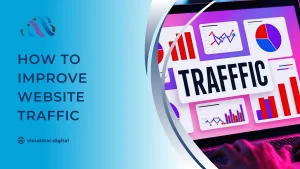In the dynamic landscape of online business, having a well-defined Digital Marketing Roadmap is paramount to achieving success. A robust road map for digital marketing not only guides your efforts but also helps you navigate the intricate pathways of the digital realm. Whether you’re a seasoned marketer or just starting, this step-by-step guide will provide you with the ultimate insights to create an effective digital marketing strategy.
What is Digital Marketing Roadmap?
A Digital Marketing Roadmap is a strategic plan that outlines the step-by-step approach to achieve your digital marketing goals. It serves as a comprehensive guide that encompasses all the essential elements of your online marketing strategy. This roadmap provides a clear direction for your digital marketing efforts, ensuring that they are cohesive, goal-oriented, and effective.
Just like a traditional roadmap helps travelers navigate a journey, a Digital Marketing Roadmap guides businesses and marketers through the complex landscape of online marketing. It typically includes key components such as defining objectives, identifying target audiences, selecting the appropriate digital channels, crafting content strategies, implementing SEO techniques, leveraging social media, utilizing paid advertising, monitoring performance, and adapting the strategy based on insights.

Step 1: Define Your Goals and Objectives
The initial step towards accomplishment is charting a course to your desired endpoint. Outline your digital marketing objectives clearly. Are you aiming for brand awareness, lead generation, increased sales, or something else? These goals will be your North Star throughout your digital marketing roadmap.
Step 2: Know Your Target Audience
Understanding your audience is the key to delivering the most impactful campaigns. Research their demographics, preferences, behaviors, and pain points. This knowledge shapes your content and messaging, ensuring it resonates with your potential customers.
Step 3: Choose the Right Digital Channels
With numerous digital platforms available, it’s crucial to select the ones that align with your target audience and goals. Whether it’s social media, search engines, email marketing, or content marketing, your chosen channels should maximize your reach and engagement.
Step 4: Develop a Content Strategy
Content lies at the heart of digital marketing. Craft quality, proper content that provides value to your audience. Incorporate your chosen keywords like “Digital Marketing Roadmap” and “road map for digital marketing” naturally to enhance your SEO efforts and boost visibility.
Step 5: Search Engine Optimization (SEO)
Optimize your online presence to rank higher on search engine results pages. Utilize your chosen keywords strategically in your website content, meta descriptions, and headers. An effective SEO strategy improves your organic traffic and widens your digital reach.
Step 6: Leverage Social Media
Social media platforms are powerful tools to build brand awareness and engage with your audience. Tailor your content to each platform, maintaining consistency in messaging. Integrate your keywords seamlessly to enhance your social media visibility.
Step 7: Email Marketing
Craft personalized and compelling email campaigns to nurture leads and retain customers. Segment your email list based on demographics and behaviors, and then deliver targeted content that appeals to their needs.
Step 8: Pay-Per-Click (PPC) Advertising
Invest in PPC campaigns to secure prime spots on search engines and other online platforms. Strategic keyword usage in your ad copy and landing pages will improve your ad’s quality score, leading to better ad placements and lower costs.
Step 9: Monitor and Analyze of Digital Marketing Roadmap
Track the performance regularly of your digital marketing efforts. Utilize analytics tools to measure website traffic, conversion rates, engagement, and more. This data-driven approach helps you to make informed adjustments while deciding a strategy.
Step 10: Adapt and Refine
The digital landscape evolves rapidly. Stay updated with industry trends and adjust your digital marketing roadmap accordingly. Adapting to new technologies and consumer behaviors ensures your strategy remains effective in achieving your goals.
What are the elements of a digital marketing roadmap?
A digital marketing roadmap includes:
Goals and Objectives: Clear and measurable targets aligned with business objectives.
Target Audience: Understanding and defining the ideal customer personas.
Channel Selection: Identifying key digital channels (SEO, PPC, social media) to reach the audience effectively.
Content Strategy: Crafting engaging and relevant content across channels.
Budget Allocation: Allocating resources and budgets for each strategy.
Implementation Timeline: Setting timelines and milestones for strategy execution.
Measurement and Analytics: Establishing metrics to track success and refine strategies for continual improvement.
What components should be included in a comprehensive digital marketing roadmap?
Objectives and Goals: Clearly defined marketing objectives that align with overall business goals.
Audience Persona: Detailed descriptions of the target audience, including demographics, interests, and pain points.
Competitive Analysis: A thorough assessment of competitors’ digital strategies and market positioning.
Digital Channels: Identification of the specific digital channels (e.g., social media, email, SEO) to be utilized.
Content Strategy: A plan for creating and distributing content that resonates with the target audience.
Budget Allocation: Clear allocation of budget and resources to various digital marketing activities.
Timeline and Milestones: A timeline with key milestones and deadlines for campaign execution.
Key Performance Indicators (KPIs): Metrics and KPIs used to measure the success and effectiveness of campaigns.
Conclusion
To conclude, a comprehensive Digital Marketing Roadmap is pivotal for a thriving online marketing strategy. Adhering to this guide equips you to craft, execute, and refine a strategy aligned with your goals and appealing to your audience. Seamlessly integrate key terms like “Digital Marketing Roadmap” for enhanced online visibility and SEO. As you embark on your digital marketing journey, remember that each step is interconnected, empowering you to make informed decisions that propel your business forward.






